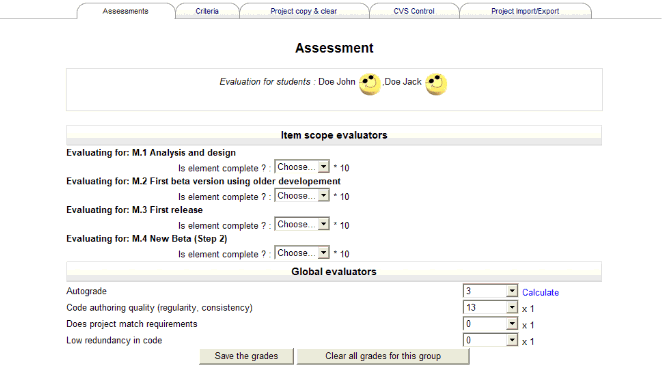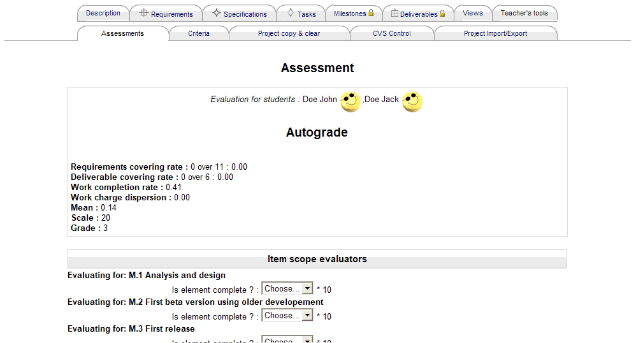mod/techproject/view/screens/assessment
Assessment can start after assessment start date. The assessment process in techproject module step 1 will use one or more grading strategies for teachers to evaluate the final project work.
Using Simple Grading Strategy
Using the simplest grading strategy assigns one unique grade to each assessable element (milestones). The module calculates the simple meangrade and delivers it to the Moodle's gradebook.
Viewing Assigned Grades
Assigned grades are viewable opening back the assessment panel. Grading lists will show the actual evaluation or "Choose..." option if no grade was given there.
Changing Gradation
Grades can be changed at any time with no limitation by the teachers.
Using Criteria Definition For Grading Project
If criteria has been enabled in the project's properties, the assessment panel reflects the defined grading strategy : each criteria set defined for assessable elements are applied to each element (in step 1, assessable elements are deadlined milestones only).
An additionnal grading form is providen if global criteria were defined.
The techproject module will calculate a mean grade using the entered grades and applying weights defined by the teacher in the criteria screen (see Definable criteria screen)
All that was told for simple grading is applicable to criteria based evaluation.
Using Autograde
The Autograde feature will evaluate the ability of the students to accept the rules of information management that are implied within the techproject module. The autograding strategy measures how well students have used information binding and work planning capabilities. We know that global indicators given in the project summary can be consistent only if information is well-defined, and accurately associated, so indicators can propagate exhaustively trough the description data model.
The Autograde uses four major indicators to know how respectful of the process the students were :
- The requirement covering rate: The program counts how many full pathes link a requirement to a remote deliverable (end to end dependency path), and calculates the rate of these covered requirements on the global amount of entered requirements.
- The deliverable plan covering: The program counts how many full pathes link back a deliverable to a remote origin requirement (end to end dependency backpath), and calculates the rate of these covered deliverables on the global amount of entered deliverables.
- The task achievement rate: The program compiles the top-level task list achievement rates.
- The workcharge balance: The program calculates an indicator that tell how fair was the workcharge balancing between the project team members.
The final autograde is an equally weighted mean of these four indicators, scaled to [0.0,1.0] and that will further be multiplied by grading scale.
Note : At this time, autograde do only calculate a final grade on numeric scales.
As autograding compilation may demand heavy calculations, the autograde is only calculated "on demand", and should be explicitely required (click on "calculate" link).
The detailed results are displayed after calculation :
Assessments and Grouping
Grades are distributed "by workspace". The calculated grade is dispatched equally to any participant of the projet (students).
Use the discussion page of this article to help us determine if some way of individualizing the grade should be provided in step 2.


